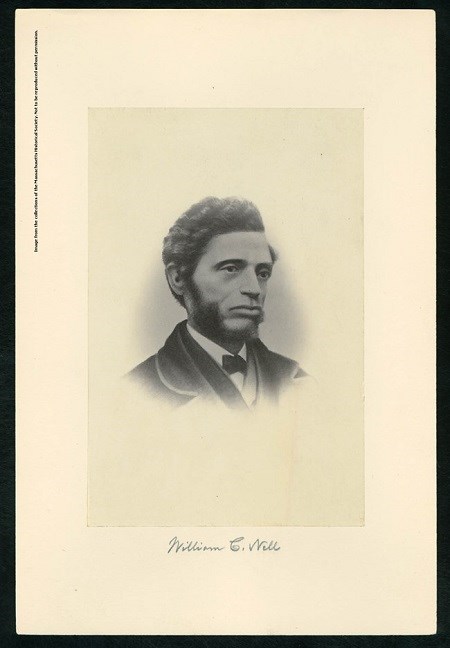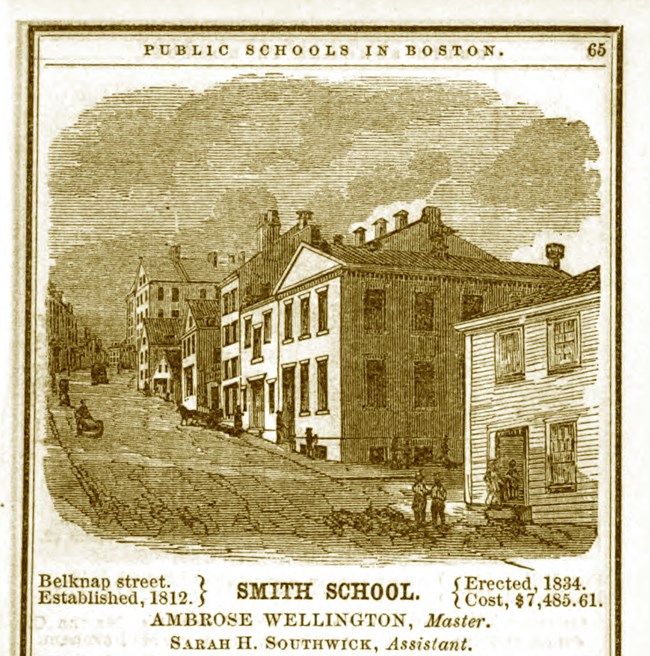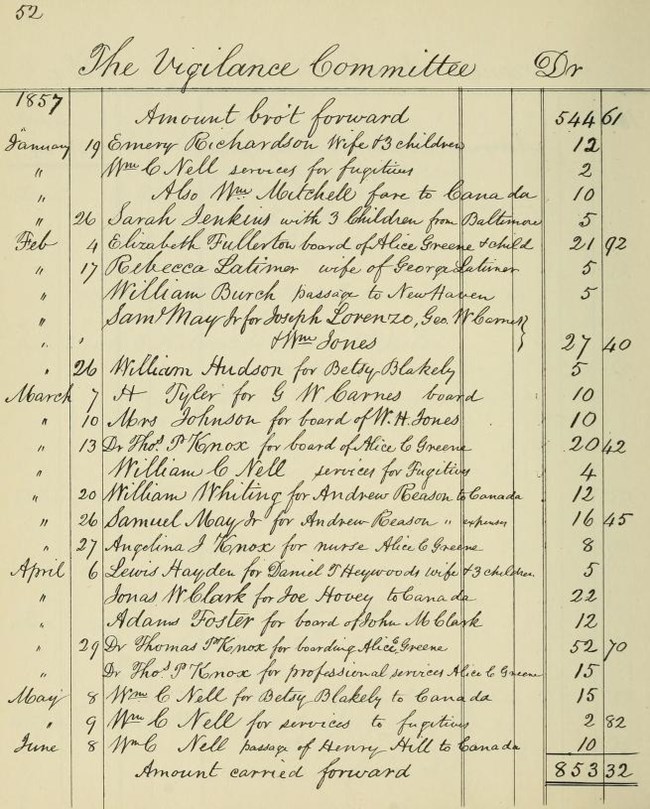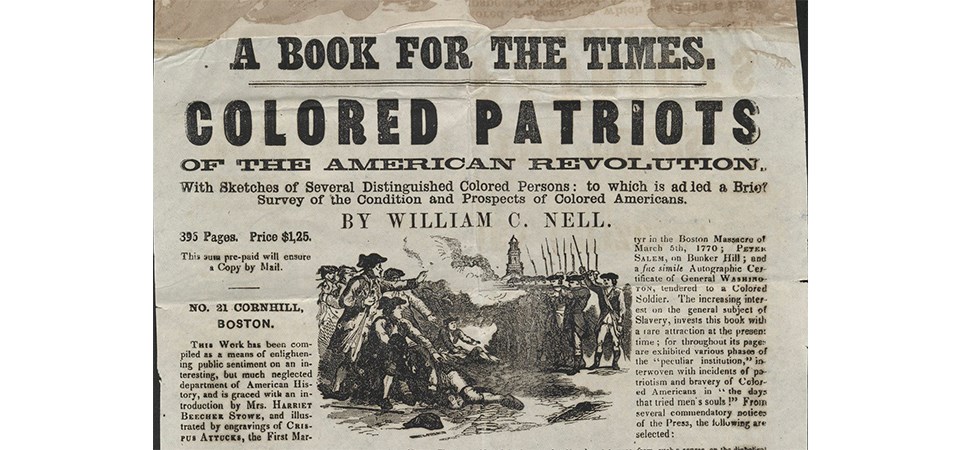Last updated: October 16, 2024
Article
William Cooper Nell: Smith Court Leader
The following article was originally published on Smith Court Stories, a digital classroom for teachers and students. Please visit the digital classroom for more articles about Activism at Smith Court.
“No man in New England has performed more uncompensated labor for humanity, and especially for his own race, than William C. Nell.”[1] William Wells Brown

Massachusetts Historical Society
Born December 16, 1816 and raised in the free Black community of Beacon Hill, William Cooper Nell became one of Boston's most influential and respected community leaders. Much of his life centered on and around Smith Court. As a student, he attended school at the African Meeting House. Both he and his parents organized and participated in community meetings there as well. He dedicated years of his life to closing the segregated Smith School on the corner of Smith Court and Joy Street. He resided at 3 Smith Court for most of the 1850s where he sheltered fugitives from slavery. While living there, Nell also wrote and published one of the earliest books on African American history.
Early Influences and Activism
Though born a few streets away from Smith Court, much of Nell's early life and influences tied strongly to the people, organizations, and institutions there. As activists themselves, Nell's parents, Louisa and William Guion exerted great influence on their son. Louisa joined the Boston Female Anti-Slavery Society that, among other things, held annual anti-slavery bazaars to raise funds for the American Anti-Slavery Society.[2] His father, William, co-founded and served as Vice-President of the Massachusetts General Colored Association. Founded at the African Meeting House in 1826, this organization dedicated itself to ending the dual forces of slavery and discrimination throughout the country. Considered a "race leader," Nell's father focused on Black collective action, petitioned Congress to end slavery, pushed for the repeal of Massachusetts discriminatory laws, and published articles in Freedom's Journal, an early Black newspaper.[3]
Nell also learned much about the struggles and achievements of African Americans from his father's close friend, David Walker, a fellow member of the Massachusetts General Colored Association and author of the incendiary antislavery and anti-racist Appeal to the Colored Citizens of the World.[4] His parents and their colleagues instilled in Nell the importance of organizing for social change and justice.
William Lloyd Garrison, the radical abolitionist editor of The Liberator, also had a profound impact on Nell during his formative years. Nell recalled:
I remember, when a boy, in January 1832, looking in at the vestry window off of Belknap Street Church, while the Editor of The Liberator and a faithful few organized the first Anti-Slavery Society.[5]
In his book, More Than Freedom, historian Stephen Kantrowitz wrote how Nell watched from Smith Court:
as his father and the other men of the Massachusetts General Colored Association assembled for a momentous ceremony: the white founders of the New England Anti-Slavery Society signing their own constitution, a document that declared slavery contrary to Christianity and American liberty, insisted on the right of citizens to protest against it, and described New England's 'unrighteously oppressed' black citizens as standing 'in need of our sympathy and benevolent co-operation.' [6]

Perhaps inspired by this night's event, Nell soon helped organize the Juvenile Garrison Independent Society, the "first organization of youths for antislavery purposes in Boston," which often met at the African Meeting House.
On October 16, 1833, at sixteen years old, Nell addressed the Juvenile Garrison Independent Society in the African Meeting House. In this speech, Nell laid out his personal beliefs that would carry him through decades of activism ahead:
Prejudice is the cause of slavery, and its attendant evils; and which, united with malice, is the cause of disunion in societies, and is the fomenter of all commotion…it is unholy…
To combat both prejudice and slavery as well as to "strengthen the cords of love existing among us," Nell called for collective action:
The colored people have been told repeatedly, that by being united, and helping one another, they will, ere long, be enabled to witness the downfall of the Colonization system, and the triumph of equal rights…a loud call is made to the young men of color to assist themselves, and by their influence, to renovate the minds of the public in defence of their national rights and liberties…- by uniting together and assisting each other – you will soon have the satisfaction of knowing that the oppressed are enabled to exclaim, "WE ARE FREE!!"[7]
As a teenager, Nell began working for Garrison as an apprentice at The Liberator, learning the skills of a publisher and journalist. He believed, along with Garrison, that The Liberator would create the "revolution in public sentiment" that Black activists sought.[8] Nell continued to contribute to The Liberator throughout its entire run, with only a brief hiatus when he moved to Rochester, New York to work with Frederick Douglass on his paper, The North Star.
Equal School Rights
In his address to the Juvenile Garrison Independent Society, Nell keenly expressed the destructive power of racial prejudice, something that he experienced firsthand a few years earlier. Barred from the nearby and better funded public schools in the neighborhood, Nell had to attend the segregated school for Black students, then housed on the ground level of the African Meeting House.
Though Boston school officials recognized Nell for his scholastic achievement, they did not allow him to attend the awards dinner held for the recipients at Faneuil Hall. Only White students could attend. Despite this, Nell persuaded a Black waiter scheduled to work the event to allow him to serve in his place. While there, he confronted one of the school officials who offered no good answer for why they excluded Black students from the ceremony. The events of that day encouraged Nell to vow that "God willing, I will do my best to hasten the day when the color of the skin will be no barrier to equal school rights."[9]

The Boston Almanac
As an adult, he followed through with his teenage vow by leading the nearly fifteen year long series of protests, boycotts, and petition drives to close down the Abiel Smith School, which had moved from the basement of the African Meeting House to its own building next door. In the mid-1840s, he co-founded the School Abolishing Party to help achieve this goal, seeing the Smith School "as both a symbol and perpetuator of racial caste."[10] Often gathering in the African Meeting House, Nell and his colleagues discussed their strategies to shut down the Smith School, create a new integrated school, and to get the Supreme Judicial Court of Massachusetts to declare separate schools unconstitutional.[11]
Their work not only inspired resistance from many White Bostonians, but also from a number of Black opponents who wished to build strong separate schools instead. One night, confrontation between Black supporters and Black opponents of the Smith School turned violent with stones being thrown during one of the meetings at the African Meeting House. Nell considered these stones "trophies of the struggle."[12]
Despite the often hostile resistance they faced throughout the long fight for equal schools, Nell and those who worked with him successfully impelled the state legislature to desegregate public schools in 1855. This legislative victory resulted from "seven petitions, two lawsuits, a major boycott, and innumerable articles, speeches, and meetings," most of which Nell either participated in or orchestrated. Charles Slack, a state legislator and ally, stated that Nell "furnished all the materials and capitol"[13] to push through this landmark civil rights legislation.
The Black community held the "Triumph of Equal School Rights" gathering in Nell’s honor on December 17, 1855 at nearby Twelfth Baptist Church. This event marked one of the few times Nell took center stage as he often played a more organizational role away from the spotlight. According to historians James and Lois Horton:
Although national leaders were a source of inspiration and pride, most activities were local, requiring regular presence and attention. Local activists like Nell were important grass-roots organizers of the black community. Theirs was the often tedious job of sustaining community action.[14]
On the day before school began in 1855, Nell, then living at 3 Smith Court, recalled watching a young Black student walking past the Smith School. "Good bye forever colored school!," the student said, "Tomorrow we are like the other Boston boys."[15]

Dr. Irving H. Bartlett collection, 1830-1880, W. B. Nickerson Cape Cod History Archives.
Underground Railroad Operative
In addition to his leadership in the equal schools struggle, Nell also figured prominently in Boston's Underground Railroad, the network of activists and organizations working to assist those fleeing southern bondage. In the early 1840s, Nell joined the New England Freedom Association, a Black organization that often met at the African Meeting House with the mission to "hide the outcast, and deliver him…out of the hands of the oppressor."[16]
Following the passage of the Fugitive Slave Law of 1850, Nell joined the biracial Boston Vigilance Committee, becoming one of its most active and instrumental members. He not only raised significant amounts of money for the committee, but he also sheltered fugitives in his home at 3 Smith Court.
Though a committed Garrisonian pacifist, he urged Blacks to defend themselves from slave catchers as they would "rid themselves of any wild beast."[17] Nell helped organize a massive protest at the African Meeting House to discuss the community’s collective response to the Fugitive Slave Law. He sought to inspire radical action by reminding his listeners of Boston's revolutionary legacy and the crucial role of African Americans, such as Crispus Attucks, in that struggle. As described by historian Stephen Kantrowitz, Nell urged them "to resist the Fugitive Slave Law as fiercely and bravely as Attucks had resisted the tyranny of the Crown."[18] By advocating such militance, Kantrowitz wrote, Nell and his allies "insisted that this was not disloyalty to American ideals or American history, but rather a defiant assertion of those national values in the face of the craven surrender of white people and political parties to the Slave Power."[19]
A Historian for Change
As evident in the anti-Fugitive Slave Law meeting, Nell saw history as a tool to inspire social change. While living at 3 Smith Court, Nell completed and released The Colored Patriots of the American Revolution, becoming the first published Black historian. He believed that telling the history of African Americans' "contributions and achievements would serve to illustrate the worth of the race to all Americans…and encourage black pride and continued accomplishments."[20] He used the history of African American military service to provoke all people to stand up for Black freedom and citizenship. He saw history as a powerful weapon in the fight against slavery, ignorance, and racism.

Houghton Library, Harvard University
In the conclusion of his book, Nell wrote of the importance of remembering and honoring those who came before:
If others fail to appreciate the merit of the colored man, let us cherish the deserted shrine. The names which others neglect should only be the more sacredly our care. Let us keep them for the hoped-for day of full emancipation, when, in the possession of all our rights, and redeemed from the long night of ignorance that has rested over us, we may recall them to memory, recollecting, with gratitude, that the stars which shone in our horizon have ushered in a glorious dawn.[21]
Though he wrote these inspiring words about an earlier generation, we can now look upon Nell as one of those "stars which shone in our horizon." When he died in 1874, the community held a memorial service for him at the African Meeting House on Smith Court, a fitting location to honor his legacy around which so much of his life and work centered.
Footnotes
[1] William Cooper Nell: Selected Writings 1832-1874, edited by Dorothy Porter Wesley and Constance Porter Uzelac (Baltimore: Black Classic Press, 2002) 55.
[2] Stephen Kantrowitz, More Than Freedom: Fighting for Black Citizenship in a White Republic, 1829-1889 (New York: Penguin, 2012) 55-56; Wesley and Uzelac, William Cooper Nell, 11, footnote 38.
[3] James Horton and Lois Horton, Black Bostonians: Family Life and Community Struggle in the Antebellum North (New York: Holmes and Meier, 1979) 61; Wesley and Uzelac, 6-7.
[4] Dorothy Porter Wesley, “Integration versus Separatism: William Cooper Nell’s Role in the Struggle for Equality.” Courage and Conscience: Black and White Abolitionists in Boston, edited by Donald M. Jacobs (Bloomingdale: Indiana University Press, 1993) 210.
[5] William Cooper Nell, Colored Patriots of the American Revolution (Boston: Robert F. Walcott, 1855) 345.
[6] Kantrowitz, More Than Freedom, 54.
[7] Wesley and Uzelac, 63-65.
[8] Kantrowitz, 52.
[9] Wesley, "Courage and Conscience," 210.
[10] Kantrowitz, 126.
[11] Wesley and Uzelac, 31.
[12] Wesley and Uzelac, 31.
[13] Wesley and Uzelac, 32-33.
[14] Horton and Horton, Black Bostonians, 69.
[15] Dorothy Porter Wesley, "Integration versus Separatism: William Cooper Nell's Role in the Struggle for Equality," Courage and Conscience: Black and White Abolitionists in Boston, ed. Donald M. Jacobs (Indiana University Press: Bloomington, 1993), pg. 213.
[16] Kantrowitz, 69.
[17] James Horton and Lois Horton, “The Affirmation of Manhood: Black Garrisonians in Antebellum Boston,” found in Courage and Conscience, 146.
[18] Kantrowitz, 201.
[19] Kantrowitz, 179.
[20] Horton and Horton, Black Bostonians, 129.
[21] Nell, Colored Patriots of the American Revolution, 379.
